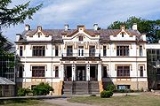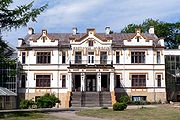
Kretinga Museum
Encyclopedia
The Kretinga Museum also known as Kretinga Manor, is located near the Baltic Sea
in Kretinga
, Lithuania
. Originally a private estate
, it was converted to a museum in 1992, and now contains a number of archeological finds, fine and applied art collections, folk art
, and ethnographic exhibits, as well as a restored orangery
. Nearby is a sculpture garden
featuring a reconstruction of a Lithuanian solar calendar
. The museum is operated by the Kretinga district municipality
.
, planted fruit trees there in the late 18th century. In 1874 the land was purchased in an auction by Count Tyszkiewicz
. In the course of creating a family manor, he converted the existing residence into a palace, built the orangery, now known as the Winter Garden , and re-landscaped the grounds. The landscaping included cascading ponds, a waterfall, arbors, fountains, sculptures, and parterres.
The idea of turning the manor into a museum is credited to Juozas Žilvitis (1903–1975); the Kretinga Museum Committee was established in 1935. The garden was completely destroyed during World War II
. In 1940 the museum became a branch of the Kaunas State Museum (now the Vytautas the Great War Museum
). In 1987 the greenhouse was rebuilt; since 1998 the Kretinga Estate Park Friends Club has been a co-sponsor.
art and works of kryždirbiai
, the traditional Lithuanian art of fashioning cross
es. Household articles include tools and furniture used during various eras.
Recent exhibitions have featured jewelry, ceramics
, printed matter of historic interest, and folk costumes. The gardens and the orangery, which contains a cafe, are frequently updated. The museum sponsors concerts, scientific and research projects, holiday specials, a "Tree Feast", and folk dance presentations.
Baltic Sea
The Baltic Sea is a brackish mediterranean sea located in Northern Europe, from 53°N to 66°N latitude and from 20°E to 26°E longitude. It is bounded by the Scandinavian Peninsula, the mainland of Europe, and the Danish islands. It drains into the Kattegat by way of the Øresund, the Great Belt and...
in Kretinga
Kretinga
Kretinga is a city in the Klaipėda County, Lithuania. It is the capital of the Kretinga district municipality. It is located east of the popular Baltic Sea resort town of Palanga, and about north of Lithuania's 3rd largest city and principal seaport, Klaipėda.The population was listed as 21,423...
, Lithuania
Lithuania
Lithuania , officially the Republic of Lithuania is a country in Northern Europe, the biggest of the three Baltic states. It is situated along the southeastern shore of the Baltic Sea, whereby to the west lie Sweden and Denmark...
. Originally a private estate
Estate (house)
An estate comprises the houses and outbuildings and supporting farmland and woods that surround the gardens and grounds of a very large property, such as a country house or mansion. It is the modern term for a manor, but lacks the latter's now abolished jurisdictional authority...
, it was converted to a museum in 1992, and now contains a number of archeological finds, fine and applied art collections, folk art
Folk art
Folk art encompasses art produced from an indigenous culture or by peasants or other laboring tradespeople. In contrast to fine art, folk art is primarily utilitarian and decorative rather than purely aesthetic....
, and ethnographic exhibits, as well as a restored orangery
Orangery
An orangery was a building in the grounds of fashionable residences from the 17th to the 19th centuries and given a classicising architectural form. The orangery was similar to a greenhouse or conservatory...
. Nearby is a sculpture garden
Sculpture garden
A sculpture garden is an outdoor garden dedicated to the presentation of sculpture, usually several permanently sited works in durable materials in landscaped surroundings....
featuring a reconstruction of a Lithuanian solar calendar
Solar calendar
A solar calendar is a calendar whose dates indicate the position of the earth on its revolution around the sun .-Tropical solar calendars:...
. The museum is operated by the Kretinga district municipality
Kretinga district municipality
Kretinga district municipality is one of 60 municipalities in Lithuania....
.

History
The manor's location had always provided shelter from maritime winds in the area. Its modern history is said to have begun when the bishop of Vilnius, Ignacy Jakub MassalskiIgnacy Jakub Massalski
Prince Ignacy Massalski was a Polish-Lithuanian nobleman.Ignacy was Bishop of Vilnius and one of the initiators of the Commission for National Education. After few years he was removed from the Commission for embezzlement of public funds...
, planted fruit trees there in the late 18th century. In 1874 the land was purchased in an auction by Count Tyszkiewicz
Tyszkiewicz
The Tyszkiewicz family was a wealthy and influential magnate family of Ruthenian/Lithuanian nobility with roots traced into the times of the Grand Duchy of Lithuania...
. In the course of creating a family manor, he converted the existing residence into a palace, built the orangery, now known as the Winter Garden , and re-landscaped the grounds. The landscaping included cascading ponds, a waterfall, arbors, fountains, sculptures, and parterres.
The idea of turning the manor into a museum is credited to Juozas Žilvitis (1903–1975); the Kretinga Museum Committee was established in 1935. The garden was completely destroyed during World War II
World War II
World War II, or the Second World War , was a global conflict lasting from 1939 to 1945, involving most of the world's nations—including all of the great powers—eventually forming two opposing military alliances: the Allies and the Axis...
. In 1940 the museum became a branch of the Kaunas State Museum (now the Vytautas the Great War Museum
Vytautas the Great War Museum
The Vytautas the Great War Museum is a museum in Kaunas, Lithuania. It was opened on 16 February 1936 and named after Vytautas the Great, Grand Duke of Lithuania. The museum displays historical artefacts pertaining to Lithuania and Kaunas from prehistoric times to the present day, including a...
). In 1987 the greenhouse was rebuilt; since 1998 the Kretinga Estate Park Friends Club has been a co-sponsor.
Exhibits and expositions
The exhibits portraying the life of the Tyszkiewicz family occupy seven halls, and contain family portraits, furniture, photographs, household objects, and paintings. The folk art exhibits contain textileTextile
A textile or cloth is a flexible woven material consisting of a network of natural or artificial fibres often referred to as thread or yarn. Yarn is produced by spinning raw fibres of wool, flax, cotton, or other material to produce long strands...
art and works of kryždirbiai
Kryždirbiai
thumb|A memorial cross in LithuaniaKryždirbystė or Lithuanian cross crafting is a traditional Lithuanian art of crafting crosses. The making of altars and crosses is an important part of Lithuanian culture...
, the traditional Lithuanian art of fashioning cross
Cross
A cross is a geometrical figure consisting of two lines or bars perpendicular to each other, dividing one or two of the lines in half. The lines usually run vertically and horizontally; if they run obliquely, the design is technically termed a saltire, although the arms of a saltire need not meet...
es. Household articles include tools and furniture used during various eras.
Recent exhibitions have featured jewelry, ceramics
Ceramic art
In art history, ceramics and ceramic art mean art objects such as figures, tiles, and tableware made from clay and other raw materials by the process of pottery. Some ceramic products are regarded as fine art, while others are regarded as decorative, industrial or applied art objects, or as...
, printed matter of historic interest, and folk costumes. The gardens and the orangery, which contains a cafe, are frequently updated. The museum sponsors concerts, scientific and research projects, holiday specials, a "Tree Feast", and folk dance presentations.

